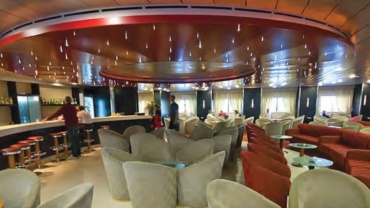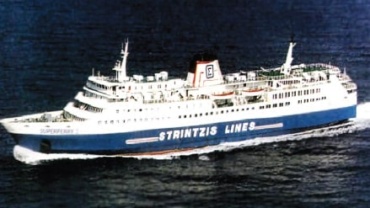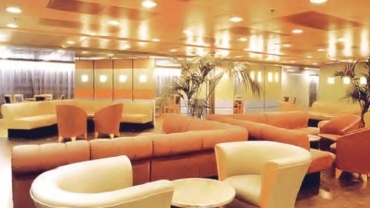
“Luxury of simplicity through patterns, colours, materials and lines, discreetly
placing before the passenger a specific attitude towards a way of looking
and of feeling. By the use of geometrical dynamic lines, with soft parabolic
and hyperbolic curves, passages of communication are created which allot,
without separating, the various areas of the vessel.”

The ships’ architect Panos Georganas once
said: “My first thought when I design, and
then build a ship is that I must create a whole
‘floating city’ which will begin to come to life
when it first puts out to sea from the harbour,
until it drops anchor at the end of every trip”.
But what exactly is his profession, and how
does it differ from that of a naval architect?
A naval architect is responsible for the
mechanical engineering equipment and
the hydrodynamic design of the vessel, in
which he seeks to balance this large hull with
the loads and the speeds on its voyages.
The shipbuilder also creates the ship’s ‘hull’,
and whatever else is relevant between the
surface of the waves and the bottom. The
architect is responsible for the visible part of
the vessel, such as, for example, its general
shape, the funnel, the decks, the staircases,
the garages, as well as the reception areas,
those where people gather, where they are
accommodated, and, above all.
Read more…

“The ‘line’ of the vessels, starting
from the stocks, expresses the
philosophy of Panos Georganas,
who approaches it as an
architectural carving.”
“A naval architect is responsible
for the mechanical engineering
equipment and the hydrodynamic
design of the vessel, in which he
seeks to balance this large hull
with the loads and the speeds
on its voyages. The shipbuilder
also creates the ship’s ‘hull’, and
whatever else is relevant between
the surface of the waves and the
bottom. The architect is responsible
for the visible part of the vessel,
such as, for example, its general
shape, the funnel, the decks, the
staircases, the garages, as well as
the reception areas, those where
people gather, where they are
accommodated, and, above all,
where they circulate on and in the
vessel.
These two specialisations initially
work together, or, at least, the
architect takes into account the
engineering infrastructure work
of the naval architect. But it is the
architect who is responsible for
whatever we see on the vessel,
from the most important items to
the smallest detail.”

